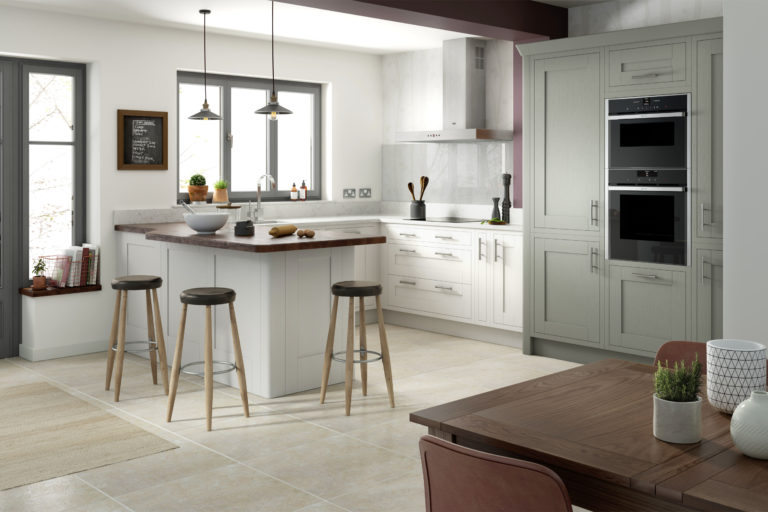
What you need to know about the 6 different types of kitchens
Everyone needs a great kitchen. It doesn’t matter how much or how little you use it. You simply must have one.
Why? Because your kitchen is the centre of your house. It’s where you go to catch a quick bite of warmed up pizza and a glass of milk before rushing off to work, late as usual. It’s where you create great early morning memories of temporary armistice between you and your loved ones.
It’s a place that feels like home.
But wanting a great kitchen and getting a great kitchen can often be two very different things. As with a lot of things that have deep emotional ties, your kitchen could feel great for reasons you can’t fully pinpoint. And it could also feel flawed, wrong or unsatisfactory for equally fussy reasons.
More often than not, the devil is in the details.
That’s why you want to start your kitchen journey right. With full knowledge of all the options available to you and a good idea of how you can get what works best for you.
Where do you want to start from?
Because your kitchen is such a sentimental place, you want to start from a place of real sentiment.
Do you want your kitchen styled in seamless, chrome and ceramic finish or do you want it in solid oak with a vintage style? Here’s where you need to pick between a modern style and a traditional style.
Traditional style
The desire to do things the old way is evoked by more than just a longing for the simplicity for the old days. Kitchens finished in traditional style also have the simple efficiency of the old ways. And there’s much sentimental value in traditional kitchens too.
With a traditional style your kitchen will not only be a place to draw closer with your loved ones. It will also be a place where you can savour the good memories that you have shared in similar kitchens in the past.
Modern style
With sleek lines, a seamless custom design and well-concealed appliances fitted by experts, modern kitchens often look like they stepped right out of your fantastic dreams of the future. There’s much to love about them, especially if you have a special bent for tech in your kitchen.
Contemporary style
And if you’re simply spoilt for choice between the vintage style of traditional kitchens with their detail, flair and larger space and the seamless, sleek design of modern kitchens, then your perfect solution is the contemporary kitchen.
The contemporary style emphasises elements from various time periods and makes them into a bespoke package that is utterly you. Here’s where you can really get down and create your dream kitchen.
Your decision on the kind of style you want will influence which of the kitchen types will be best for you. Now let’s get into kitchen types.
What are the most common kitchen types?
We’ve curated 6 different types of kitchen that you can choose from. They all have their unique selling points and distinctive features. But they all have one thing in common: they determine your kitchen layout.
Your layout basically determines everything about how you’ll use the kitchen. It will determine how you cook, how you eat, how you socialise and how far you have to go to get stuff from the fridge.
Single walled
If you don’t have a lot of space and need to maximise the area you have, single-walled kitchen will work for you just fine. It streamlines your entire kitchen layout, so your cooking area and appliances are arranged along one wall.
This way, you can make the most of a small apartment and keep everything within easy reach in a stylish layout. You won’t have much room for countertops and storage though. You might want to consider an island (with plenty room for drawers) if you need more space.
U-Shaped
This kitchen layout is more commonly used for larger kitchen spaces although it can be adapted to a smaller space. It allows you to maximise your storage space by having cupboards and drawers on three walls of the kitchen.
When adapted to a smaller space, it might be difficult to find space for chairs and a meal space on the countertop. But a great trade-off is having your fridge, sink and cooking space in easy reach, making for a very practical space.
L-Shaped
Perfect for studio apartments, this layout helps ensure that you make the most of your corner space. It then leaves bare a large chunk of room space that can be maximised to provide for a dining and even sitting area.
You’ll have a continuous working platform with this layout and if you want to improvise, you can even add an extension on the side that can be used as a meal space.
Peninsula
This layout provides you with the continuous workspace of an L-shaped kitchen and the utility of a U-shaped kitchen. It’s a good idea to use a peninsula if you don’t have that much space but want the functionality of an island.
It allows you have and extra work or meal area that operates like an island but is connected to the main kitchen on one side. So it gives you all the resourcefulness of an island worktop but takes less space.
Galley Kitchen
Also called the parallel kitchen, this layout has two runs of parallel worktops with a walkway in the middle. It’s the best possible layout for cooking enthusiasts and professional chefs because it leaves you with everything to hand with a minimum of fuss. That’s why it’s the preferred layout for celebrity chefs.
It’s the most efficient of layouts as far as cooking is concerned and it leaves you with much freedom to divide the parallel worktops as you like. You can divide them into wet and dry areas or cooking and washing on one side and appliances on the other.
Island Kitchen
If you have a lot of space to spare and want to create a kitchen that is both cosy and spacious, the island layout is just for you. The layout includes a countertop in the middle of the kitchen, unattached to the rest of the kitchen and providing access from all sides.
So you can work all around the island and use it either as an additional food preparation worktop or even for quick meals. The free access on all sides of the island makes moving around the kitchen easy and you don’t have to worry about turning your back on family or guests when cooking.
What determines your choice of Kitchen type?
Even after assessing all the layouts available to you, your decision on which layout to plump for must wait until you have considered these factors:
Space
As you must have noticed already, space plays a large part in the type of layout you can pick for your kitchen. For instance, if you don’t have a lot of space available, it won’t make much sense for you to pick an island kitchen layout.
Working triangle
The working triangle takes into account the optimal distance your cooking area, worktop and appliances need to be from each other in order to have a functional kitchen space.
Since you’ll be making several trips between each of those spots, you need to pick the best layout that optimises your working triangle and keeps you from having to go far on each trip.
Household size
It won’t make much sense to go for a very large kitchen when you have a very small house. It can actually make the kitchen much less cosy than if you pick a layout that is compact and warm.
Lifestyle
Even if you don’t have a big house, your lifestyle and the volume of guests you receive may make the choice of a bigger kitchen space necessary. So you may need to go for a more spacious layout.
Talk to the experts
The experience of constructing your own kitchen is not one you have every day. Most are lucky to even have the privilege of doing it twice in their lifetime. So it’s important to get it spot on right from the off.
Since you don’t often get the chance for retakes, it’s best to start off on the right foot, with solid professionals guiding you every step of the way. With great advice and even better hands, you’ll get the dream kitchen you’ve always wanted.









